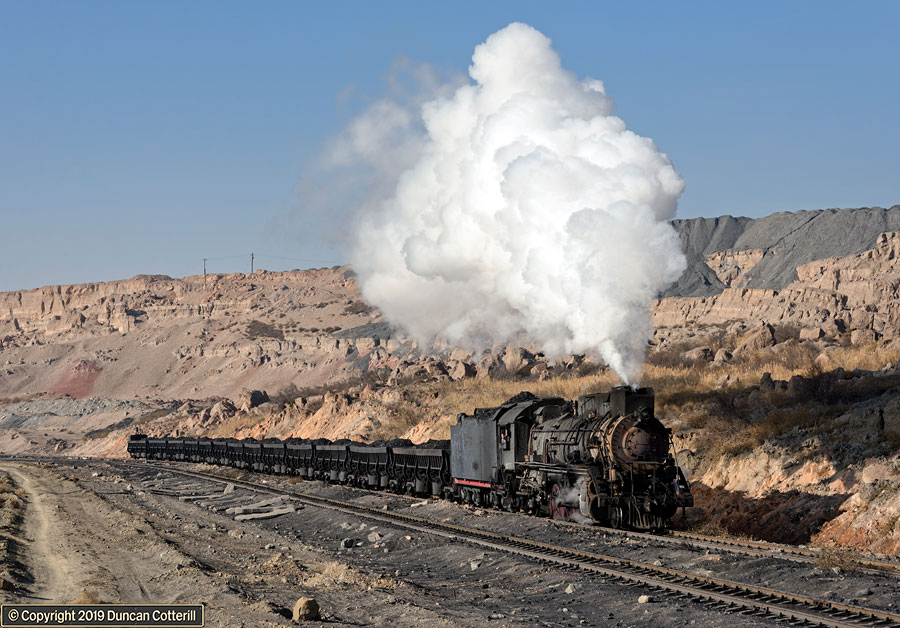STEAM, SNOW AND SAND
industrial steam in the frozen north and the deserts of the west
China - 18 November to 11 December 2017 - Report by Duncan Cotterill
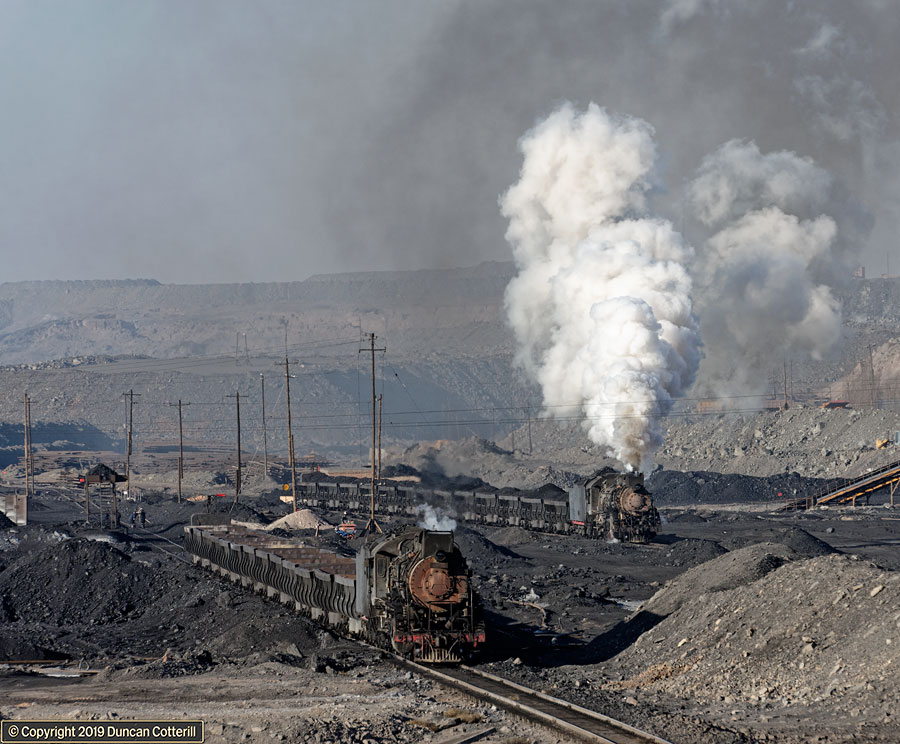
Busy Morning at Xikeng
JS.8190 got underway with a loaded train on the morning of 6 December 2017, passing JS.8173, waiting for some surveyors to finish work before backing down to replenish its tender. Sandaoling's opencast rail system had been expected to close in May 2017 but received a 2 year reprieve at the last minute.INTRODUCTION
When November comes around, it’s time to dust off the thermals and set off for China. 2017 was no different and the usual suspects gathered at Beijing’s Capital Airport on 18 November, looking forward to visiting Wujiu, in the frozen North-East and Sandaoling in the slightly less frozen deserts of the far west.HOME TO WUJIU
17 to 19 November 2017I travelled from London to Beijing with Finnair, meeting up with Peter in Helsinki and Xiaolan in Beijing. We left our luggage at the airport and travelled into Beijing on the Airport Express rapid transit to Dongzhimen, followed by a short ride on Subway Line 2 to Beijing station. I photographed diesels and electrics from the Dongnan Jialou tower on the old city walls for a few hours. More details of all main line modern traction sightings can be found near the end of the report. Then it was time to head back to the airport via the Paulaner Bräuhaus (near Liangmaqiao subway station) for a traditional meal of Bier und Wurst.
Beijing Approach
SS9G.0127 approached Beijing with Z10, the 17:17 overnight express from Hangzhou, on 18 November 2017.In the background DF11G twin unit DF11G.0059 and 0060 waited to go on shed after depositing its train in the carriage sidings. The DF11G had arrived from Nantong around an hour earlier.
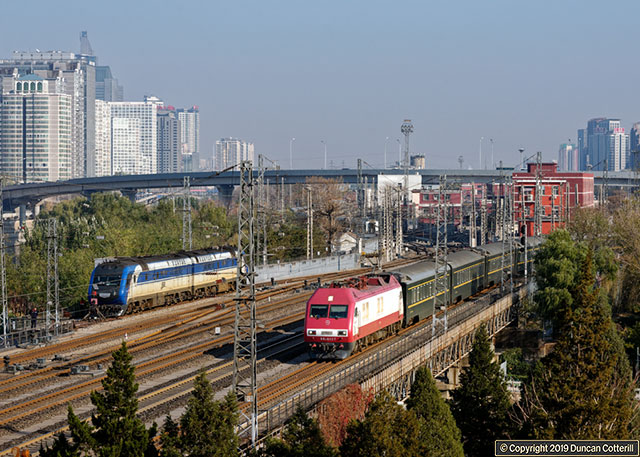
We then took Air China’s 20:00 flight to Haila’er, where our driver, Mr Xiao, met us. After a night in the Hulunbuir Bojue Hotel we left for Wujiu by road, taking just over 2 hours for the journey. As we approached, steam could be seen rising from near the loader at the new Shengli Kuang (mine), where we found SY.1225 starting to load a 30 wagon train.
During our visit most of the railway activity was centred around the new mine, Shengli Kuang, south west of Wujiu town. The mine saw trains on 6 of the 7 days we were there but usually only one train each day in daylight. There was also a daylight train to the Sankuang loading point on one day. We were aware of overnight work at both Sankuang and Shengli during the time we were at Wujiu but it wasn’t observed. Neither Yikuang nor Erkuang loading points appeared to be in use and we saw no activity at either mine.
WUJIU MINING RAILWAY
19 to 25 November 2017During our visit most of the railway activity was centred around the new mine, Shengli Kuang, south west of Wujiu town. The mine saw trains on 6 of the 7 days we were there but usually only one train each day in daylight. There was also a daylight train to the Sankuang loading point on one day. We were aware of overnight work at both Sankuang and Shengli during the time we were at Wujiu but it wasn’t observed. Neither Yikuang nor Erkuang loading points appeared to be in use and we saw no activity at either mine.
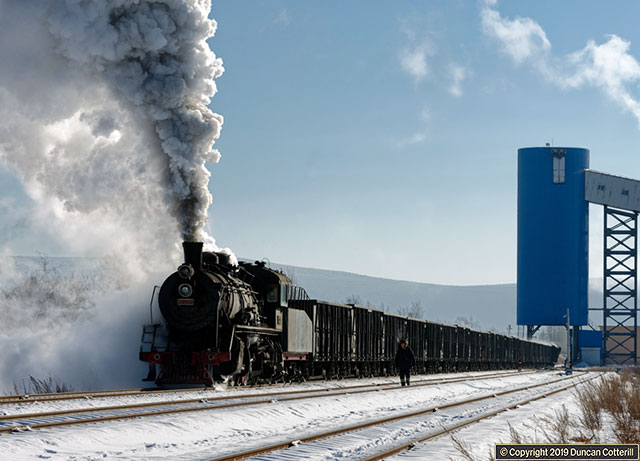
Shengli Mine Loader
SY.1225 put on a good display while working the loader at Shengli Mine on 19 November 2017.It wasn't like this all the time, in fact such eruptions were rare and short lived and you had to be in position or you would miss them. That meant a lot of standing around with a camera at the ready in temperatures of -30C or below.
The same two locos that we saw last year were in service, SY.1225, looking much scruffier than last year, and DF4DD.0288, the line’s only diesel. SY.1134 and SY.1546 were in the shed at Wujiu in very similar positions to last year and, initially, we assumed they hadn’t been used in the meantime. Later Mr Xiao showed us pictures of SY.1546 in use in July 2017 and we were told by railway staff that the steam locos were regularly rotated with each being used for about 4 months every year. Apparently the plan was for SY.1225 to remain in use until Spring Festival 2018, when it would be swapped with one of the others, presumably SY.1134. During our visit last year the SY used to go to Yikuang to coal but this year it was coaled by a front end loader at the watering point, not far east of Wujiu station. Ashing out still took place at the west end of the station.
The diesel was used on all trains to or from the CNR exchange sidings at Meitian and also on some internal workings between Wujiu and Sankuang or Shengli Kuang. It would usually deliver empties to the small yard just north of Shengli Kuang and collect the loaded wagons from the same place, leaving the SY to shunt them under the loader. On at least one occasion the diesel performed the shunting as well. We had hoped that the SY might work trains between the yards at Shengli Kuang and Wujiu but we only saw this happen on two occasions, once in each direction. The rest of the time the wagons for Shengli were worked directly to or from Meitian by the diesel.
Likewise the diesel worked empties for Sankuang from Meitian to Wujiu where steam took over, propelling the wagons tender first uphill to Sankuang and returning chimney first downhill with the loads, which would be diesel hauled from Wujiu to Meitian. We were also aware that the diesel had been to Sankuang overnight on at least one occasion.
The diesel was used on all trains to or from the CNR exchange sidings at Meitian and also on some internal workings between Wujiu and Sankuang or Shengli Kuang. It would usually deliver empties to the small yard just north of Shengli Kuang and collect the loaded wagons from the same place, leaving the SY to shunt them under the loader. On at least one occasion the diesel performed the shunting as well. We had hoped that the SY might work trains between the yards at Shengli Kuang and Wujiu but we only saw this happen on two occasions, once in each direction. The rest of the time the wagons for Shengli were worked directly to or from Meitian by the diesel.
Likewise the diesel worked empties for Sankuang from Meitian to Wujiu where steam took over, propelling the wagons tender first uphill to Sankuang and returning chimney first downhill with the loads, which would be diesel hauled from Wujiu to Meitian. We were also aware that the diesel had been to Sankuang overnight on at least one occasion.
Steam & Diesel
Both of Wujiu's working engines were in the yard at 11:25 on 23 November 2017. The diesel was setting off for Meitian with a short rake of loads, probably filled overnight at Sankuang, while SY.1225 prepared for another exciting afternoon shunting the loader at Shengli.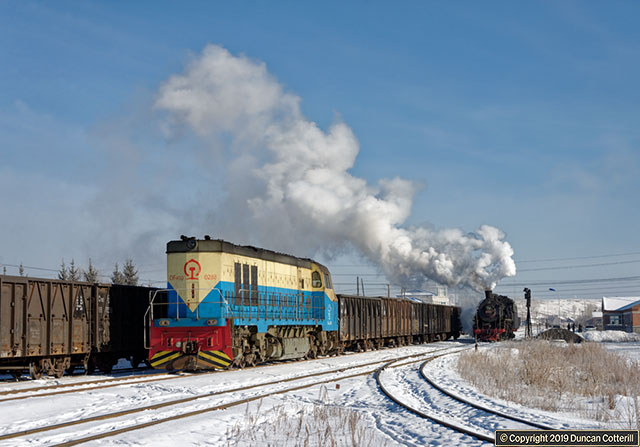
The timing of trains varied considerably from day to day and depended mainly on when CNR delivered empty wagons for loading. The loader at Shengli is aligned roughly north-south and activities were almost impossible to photograph between around 09:30 and 11:45. The light was best in the afternoon with few shadow problems until just before sunset. The Shengli branch appears to be fairly level and the loco didn’t have to work particularly hard when shunting the loader or moving wagons to or from the yard.
Trains to Shengli usually consisted of around 50 wagons, each of which took around 4 minutes to load when things were working smoothly, so a train could be loaded in 3 to 4 hours, or it could take all day if there were problems with the loader, as there often were. Unlike some loaders, each wagon only made one pass here with coal being added or removed later at Meitian to balance out loadings.
When there wasn’t any work for the locos they returned to the shed. Even with Shengli Mine to work, as well as Sankuang, there were long periods of no activity and the operating plan seemed to change frequently and at short notice, making it risky to stray far from Wujiu when the engine had no planned work.
Trains to Shengli usually consisted of around 50 wagons, each of which took around 4 minutes to load when things were working smoothly, so a train could be loaded in 3 to 4 hours, or it could take all day if there were problems with the loader, as there often were. Unlike some loaders, each wagon only made one pass here with coal being added or removed later at Meitian to balance out loadings.
When there wasn’t any work for the locos they returned to the shed. Even with Shengli Mine to work, as well as Sankuang, there were long periods of no activity and the operating plan seemed to change frequently and at short notice, making it risky to stray far from Wujiu when the engine had no planned work.
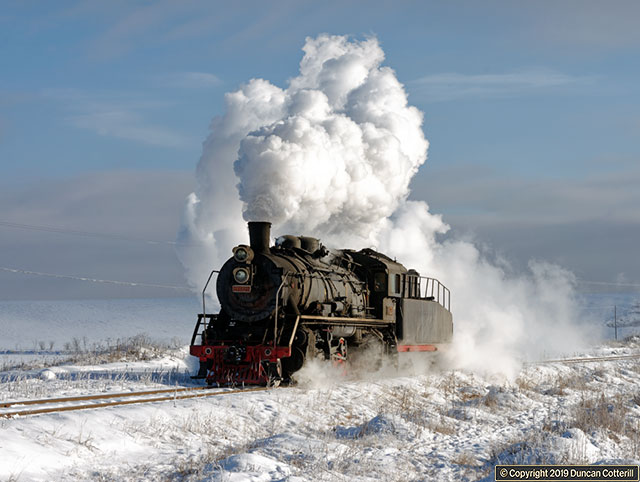
Catching The Light
The morning of 22 November 2017 was fairly cloudy but the sun caught SY.1225 returning from Sankuang light engine after delivering empties to the loading point there.Locos don't have to work hard to produce a good exhaust when the temperature is way below zero. Unfortunately sights like this are rarely seen at Wujiu. It's one of those systems where chimney first workings are all downhill and getting a good pile of clag from the chimney is a real challenge.
One day there was no traffic at all and on another it was cloudy but the remaining 5 days were largely sunny. Temperatures were as low as -36C first thing in the morning but rose to a balmy -20C or so by mid afternoon. Our driver reported -44C the day after we left and said -50 or below was fairly common in mid-winter. We stayed at the Linyuan Hotel in Wu’erqihan, same as last year.
Wujiu isn’t the busiest or most photogenic steam operation in China but it’s probably the second best now, after Sandaoling, and it’s a nice place to visit, despite the cold. You do need patience to get the most from a visit as there’s lots of hanging about waiting for something to happen.
Wujiu isn’t the busiest or most photogenic steam operation in China but it’s probably the second best now, after Sandaoling, and it’s a nice place to visit, despite the cold. You do need patience to get the most from a visit as there’s lots of hanging about waiting for something to happen.
A Grand Finale
It's not very often that you find Wujiu's locos working hard but when they do, the exhaust effects can be spectacular. SY.1225 pushed a train of empties back towards Shengli Mine on the morning of 25 November 2017, bringing our visit to a very satisfactory close. This was the coldest morning of our visit with a temperature of -36C and, even with all the thermal gear, operating the camera was a painful experience.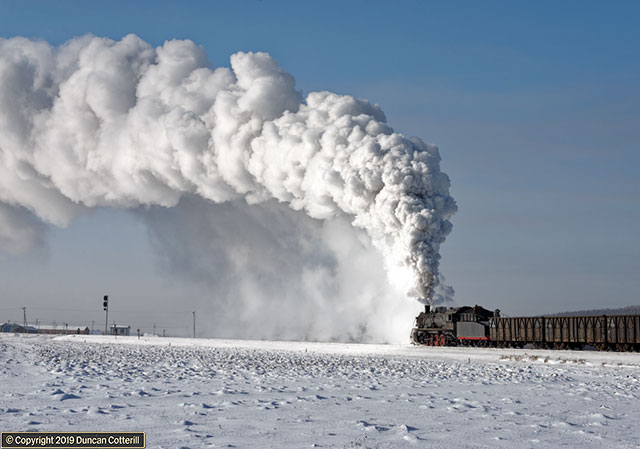
WUJIU TO SANDAOLING
25 to 27 November 2017After spending the first half of the morning of the 25th at Wujiu, we watched SY 1225 propelling a train of empties towards Shengli Mine then left for Haila’er and our afternoon flight back to Beijing. After an on time arrival, we took the courtesy bus to the CITIC hotel where we met up with Bryan.
We should have flown to Hami on the 26th but Air China cancelled our flight with about 2 weeks notice, meaning we had to spend an extra day in Beijing. As the weather was unusually clear, we took a taxi into the city and returned to the Dongnan Jialou at Beijing station for some more diesel and electric photography. Then it was time for a walk in Beihai Park and a duck for dinner (not sourced from the park) before returning to our hotel by subway, Airport Express and courtesy bus.
A very early start on the 27th saw us out of the hotel at 05:00. It was too early for the hotel courtesy bus but they arranged a minibus for us, at a price of course. The airport was busy but we still managed to negotiate the long queues at check-in and security and made the 07:25 flight to Hami with time to spare. Departure was 10 minutes ahead of schedule and we arrived at Hami a remarkable 40 minutes early, then continued by road to Sandaoling, where we would spend the next 11 days.
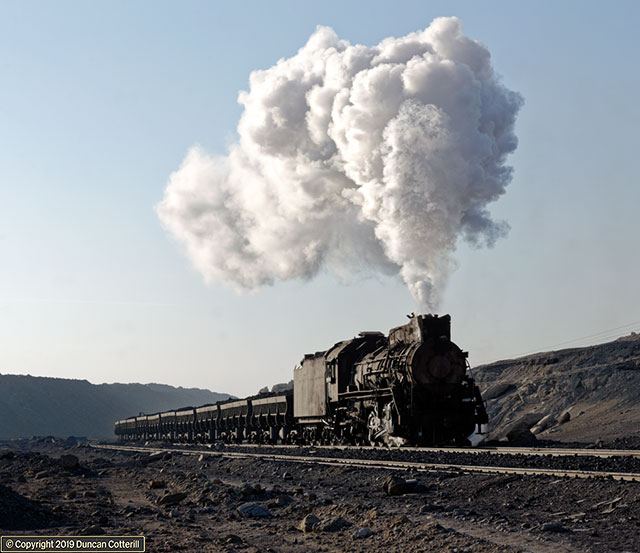
Fast & Frequent
JS.8167 was in fine form on the afternoon of 2 December 2017 as it whisked 13 bucking and swaying KF60s out of the pit, bound for Xuanmeichang with another load of opencast coal.This was one of 15 loaded trains dispatched from Xikeng in just over 7 hours on that day, the busiest of our trip.
SANDAOLING MINING RAILWAY
27 November to 8 December 2017Despite the dire predictions, there was little evidence of significant change since last November, although there were probably slightly fewer trains overall. There were still four coal trains working in the opencast pit every day. Loading was still taking place at the blue loader at Xikeng and by electric shovel from piles of coal closer to Ba’erzhan. Trains were still going to unload at the Xuanmeichang washery and the Jianmeixian unloading point between the workshops and Nanzhan. Most importantly, the locos were still being worked hard.
We saw five JS in use in the opencast mine, JS.6224, 8167, 8173, 8190 and 8225. JS.8173 replaced JS.6224 on 30 November and then JS.6224 replaced JS.8190 on 7 December. The two most capable engines, JS.8167 and JS.8225 worked throughout.
Big Sky Country
In common with many of the world's flatter places, Sandaoling enjoys some spectacular sunrises and sunsets. JS.8225, nearest the camera, and JS.8190 waited to begin the day's work at Dongbolizhan as the eastern sky turned red on the morning of 28 November 2017.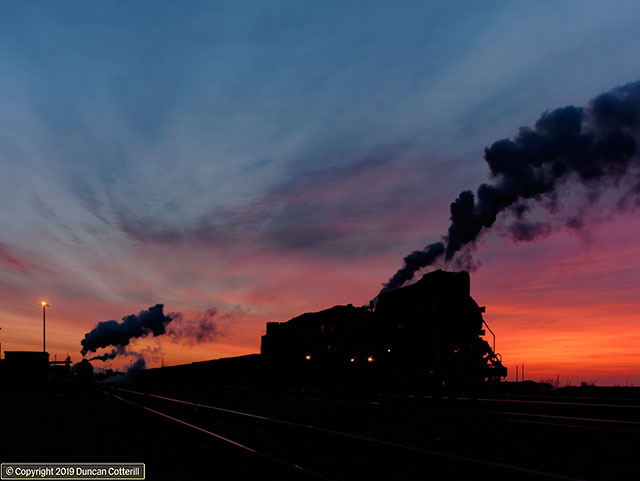
Shift change still took place at Dongbolizhan between 08:30 and 09:00. The last train in would usually arrive before 08:30 and the first one out usually left around 09:00. The “passenger" continued to run as a light engine to Ba’erzhan, nominally at 08:40 but in practice as soon as the passenger (singular) turned up, often just after 08:30. It was usually back at Dongbolizhan by 09:00. The locos took water at Dongbolizhan during the shift change but coaling took place at Xikeng during the day, as determined by the loco’s needs and the availability of a front end loader to do the coaling.
Most trains loaded at the blue loader at Xikeng but the electric shovel towards the Ba’erzhan end of the Xikeng sidings loaded some trains as well. Counting from the south, the shovel loaded trains on lines 1 or 2. Locos were usually coaled on line 2. Line 3 was used by all trains to/from the blue loader. Line 4, which used to be the through line to Xibolizhan, wasn’t used by coal trains but a light engine used it to go beyond Xikeng one afternoon and returned with an assortment of wagons.
The number of trains using the shovel varied considerably from one day to the next, with 4 or 5 on some days and none on others. The loader could produce anything between 5 and 10 trains between 10:00 and 18:00, usually with gap of up to 2 hours at lunchtime. The shovel often started loading at the beginning of the day’s operations and once got a train away at 10:10, earlier than anything the loader managed. However, it always seemed to finish around 16:00. After that all trains loaded at the blue loader.
Most trains loaded at the blue loader at Xikeng but the electric shovel towards the Ba’erzhan end of the Xikeng sidings loaded some trains as well. Counting from the south, the shovel loaded trains on lines 1 or 2. Locos were usually coaled on line 2. Line 3 was used by all trains to/from the blue loader. Line 4, which used to be the through line to Xibolizhan, wasn’t used by coal trains but a light engine used it to go beyond Xikeng one afternoon and returned with an assortment of wagons.
The number of trains using the shovel varied considerably from one day to the next, with 4 or 5 on some days and none on others. The loader could produce anything between 5 and 10 trains between 10:00 and 18:00, usually with gap of up to 2 hours at lunchtime. The shovel often started loading at the beginning of the day’s operations and once got a train away at 10:10, earlier than anything the loader managed. However, it always seemed to finish around 16:00. After that all trains loaded at the blue loader.
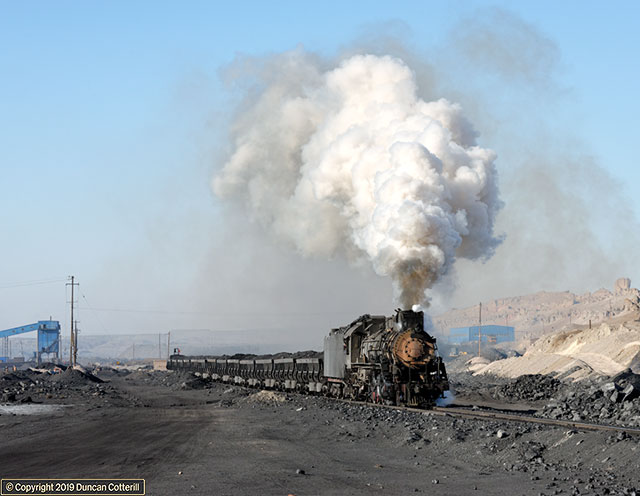
Leaving The Loader
JS.8167 was always a good bet for putting on a show for the camera and didn't disappoint when it left the Xikeng loader with a loaded train for Xuanmeichang at midday on 6 December 2017.The busiest day at both the loader and shovel was the Saturday with a total of 15 loaded trains dispatched in just over 7 hours. When the management’s away the workers can get on with the job! The worst day was the first Wednesday with only 7 loaded trains in a similar period.
If all went smoothly the shovel could load a train in 45 minutes compared with 25 to 30 minutes at the blue loader. All the trains we saw leave the loader went to the Xuanmeichang washery and almost all the trains from the shovel went to Jianmeixian. The first loaded train of the day usually left the pit around 10:20 to 10:40 but it was 11:30 before anything ran on one day and there was never a train out before 10:10.
With four trains in service most of the time congestion was an issue, particularly if all four were shuttling between the blue loader and the washery. On numerous occasions uphill loaded trains were held at signals, sometimes because of poor regulation of empties but often for no good reason at all. In similar situations in previous years, one or even two trains would be taken out of the circuit and parked up at Dongbolizhan but all four usually remained in use this time.
If all went smoothly the shovel could load a train in 45 minutes compared with 25 to 30 minutes at the blue loader. All the trains we saw leave the loader went to the Xuanmeichang washery and almost all the trains from the shovel went to Jianmeixian. The first loaded train of the day usually left the pit around 10:20 to 10:40 but it was 11:30 before anything ran on one day and there was never a train out before 10:10.
With four trains in service most of the time congestion was an issue, particularly if all four were shuttling between the blue loader and the washery. On numerous occasions uphill loaded trains were held at signals, sometimes because of poor regulation of empties but often for no good reason at all. In similar situations in previous years, one or even two trains would be taken out of the circuit and parked up at Dongbolizhan but all four usually remained in use this time.
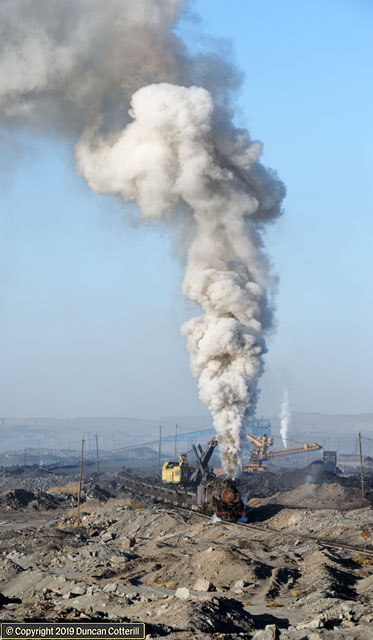
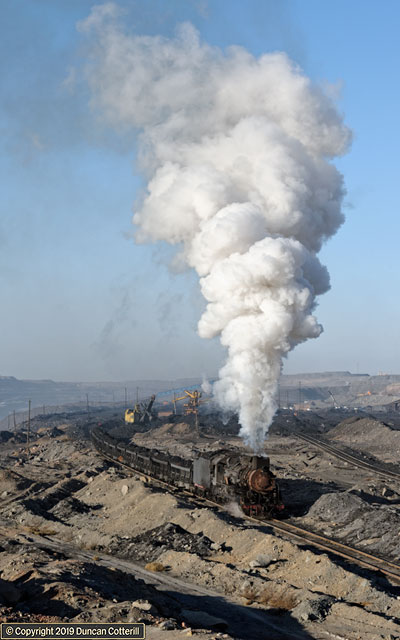
Second Time Lucky
Departures from the electric shovel at Xikeng could be spectacular as trains had to climb away from the loader on rails made slippery by crushed coal dust. JS.8173 stalled on its first attempt on the morning of 30 November 2017 (left). After setting back and trying again, it made a successful departure (right).We had several visits to the Nanzhan side of the operation but, as usual, it wasn’t worth the effort. Three afternoons waiting on the line to Beiquan Erjing didn’t produce a single train. The short uphill section leaving Erjing is currently a building site with all the potential positions ruined and the going away shot for empties with the shan behind looks straight into the shiniest pylons I’ve ever seen. We did see JS.8358 and JS 8366 shunting at Nanzhan. Trains to Liushuquan and Shadunzi seemed to be more frequent than before but all were worked by the DF8B diesels. DF8B.0247 and DF8B.0250 were seen in use. The through trains to Shadunzi appeared to change engines at Nanzhan, swapping one diesel for another for reasons unknown.
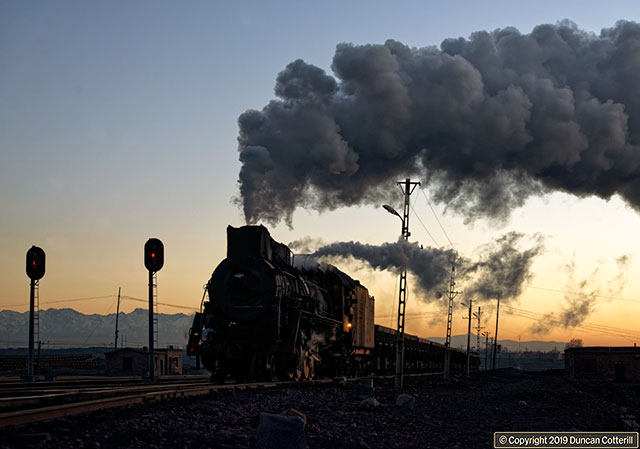
Late Arrival
JS.8225 rolled into Dongbolizhan at dawn on 30 November 2017. Although it was still 10 minutes to sunrise, it was unusual to find a train arriving so late for servicing. The crews had swapped over earlier at the Kengkouzhan headhunt.The weather was remarkably good during our visit with clear skies almost the whole time. There was a cloudy spell for a couple of hours one morning, but only after the most spectacular sunrise, and we also had one cloudy afternoon but that was it for poor weather. The Tianshan were visible on all but one day and often as clear as I’ve ever seen them. Although it didn’t feel too cold (after -36C at Wujiu it probably wouldn’t), we only lost the exhaust on one train the whole time we were at Sandaoling.
There were very few other photographers around most of the time we were at Sandaoling, a couple of Brits with Mike Ma and another with Jun were the only other westerners we saw. There were a few Chinese enthusiasts but generally in ones and twos and we didn’t see much of them. One large undisciplined group turned up on the Sunday morning at Dongbolizhan, after the best light had gone, and spent half an hour getting in each others way as they photted every rivet on one of the locos. I suspect a camera club rather than enthusiasts as they clearly didn’t know how to behave safely around locomotives. Fortunately they didn’t stay for long. Another large group, this time from Hong Kong, turned up on our last morning but seemed much more clued up and weren’t a problem.
There were very few other photographers around most of the time we were at Sandaoling, a couple of Brits with Mike Ma and another with Jun were the only other westerners we saw. There were a few Chinese enthusiasts but generally in ones and twos and we didn’t see much of them. One large undisciplined group turned up on the Sunday morning at Dongbolizhan, after the best light had gone, and spent half an hour getting in each others way as they photted every rivet on one of the locos. I suspect a camera club rather than enthusiasts as they clearly didn’t know how to behave safely around locomotives. Fortunately they didn’t stay for long. Another large group, this time from Hong Kong, turned up on our last morning but seemed much more clued up and weren’t a problem.
Under The Tianshan
JS.8173 ran around the curve leading to the headhunt at Jianmeixian with a loaded coal train on 3 December 2017.The snowcapped peaks of the Tianshan, 50km away and rising to 4000m above sea level, are clearly visible in the distance. Sandaoling itself is around 1000m above sea level
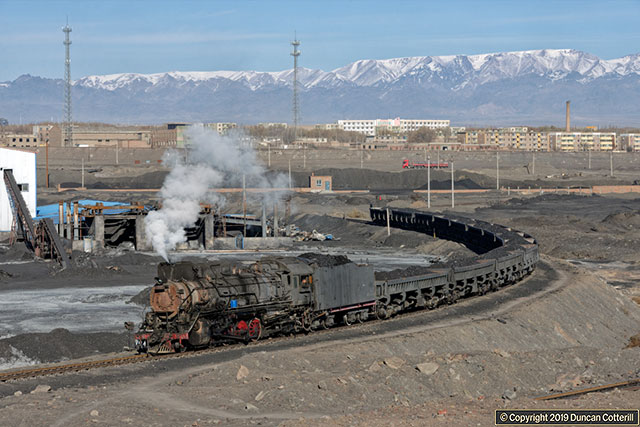
SANDAOLING TO HOME
8 to 11 December 2017We left the pit at 11:00 on 8 December after seeing the first 3 trains out of the pit, then left Sandaoling at 12:50 for Hami Airport, arriving in plenty of time for our 16:40 flight back to Beijing. Frustratingly it was reported as delayed indefinitely due to “air traffic congestion”, in this case military exercises, and our aircraft eventually arrived an hour late. We left an hour late and were still an hour late when we arrived in Beijing. We stayed at the Swissotel this time, closer to the city centre, travelling there by Airport Express to Dongzhimen and then subway Line 2 to Dongsi Shitiao.
The 9th was spent on a very leisurely trip to the museum by subway and taxi. We went to Wangjing Nan station on Line 14 but Jiangtai would have been a better choice and that’s the way we returned. Most taxi drivers don’t seem to know where the museum is and usually need guidance to get there. Ironically it’s easy to get a taxi from the museum to anywhere, as there’s are usually dozens of them parked just outside the main gate.
Nothing much to report from our visit. There were a few new diesels and electrics outside the main building (SS1.0681, DF7C.5006, SS4.0168 and SS4G.6001) but nothing of note otherwise apart from the interior becoming even more cluttered and the exhibits less easy to view.
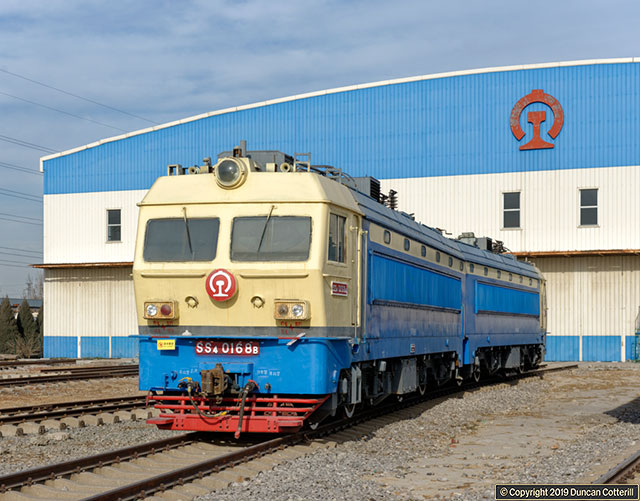
Museum Piece
SS4.0168 is one of several new modern traction additions to the collection at the Beijing Railway Museum, photographed on 9 December 2017.The 10th was spent visiting the Ming Tombs, north-west of Beijing. The journey there and back was more interesting than the tombs themselves. We took Subway Line 2 from Dongsi Shitiao to Dongzhimen and then Line 13 to Xi’erqi and finally the Changping Line to Ming Tombs station.
The Ming Tombs subway station seemed to be a work in progress, a brand new structure in the middle of an area that appeared to be scheduled for demolition. It’s nowhere near the tombs and the connecting buses don’t stop anywhere near the station. The 13 tombs are scattered across the hillsides around 15km to the north and the Sacred Avenue, lined with statues, is more than 5km away. Public transport information is almost non-existent at the station.
We ended up paying an enterprising local to take us to the main tomb and back in his SUV. There wasn't much to see in the tomb and the best of the artefacts found there have gone to other museums, leaving only a few bits and pieces on display. There are some nice buildings but they're too treed in for good photos. A very strong wind made it rather unpleasant to hang around outside.
With a little bit of effort to provide joined-up transport, information and signage, getting to the tombs and between them could be straightforward but at the moment it’s difficult and, frankly, not worth the hassle.
We left the hotel just after 07:30 on the 11th, taking subway Line 2 to Dongzhimen and the Airport Express to Terminal 3, arriving at 08:20. Check in, emigration and security were all painlessly negotiated. Our Finnair flight loaded quickly and pushed back 10 minutes ahead of schedule, only to join a very long queue of planes waiting to take off. Fortunately the delay wasn’t long enough to endanger our connections at Helsinki and the rest of the journey was uneventful.
The Ming Tombs subway station seemed to be a work in progress, a brand new structure in the middle of an area that appeared to be scheduled for demolition. It’s nowhere near the tombs and the connecting buses don’t stop anywhere near the station. The 13 tombs are scattered across the hillsides around 15km to the north and the Sacred Avenue, lined with statues, is more than 5km away. Public transport information is almost non-existent at the station.
We ended up paying an enterprising local to take us to the main tomb and back in his SUV. There wasn't much to see in the tomb and the best of the artefacts found there have gone to other museums, leaving only a few bits and pieces on display. There are some nice buildings but they're too treed in for good photos. A very strong wind made it rather unpleasant to hang around outside.
With a little bit of effort to provide joined-up transport, information and signage, getting to the tombs and between them could be straightforward but at the moment it’s difficult and, frankly, not worth the hassle.
We left the hotel just after 07:30 on the 11th, taking subway Line 2 to Dongzhimen and the Airport Express to Terminal 3, arriving at 08:20. Check in, emigration and security were all painlessly negotiated. Our Finnair flight loaded quickly and pushed back 10 minutes ahead of schedule, only to join a very long queue of planes waiting to take off. Fortunately the delay wasn’t long enough to endanger our connections at Helsinki and the rest of the journey was uneventful.
Open Country
DF11.0143 led train K7093/7096/7097 through the wide open spaces north of Wu'erqihan on 24 November 2017. The 18:10 Harbin Xi to Haila'er passenger was already over 20 hours into its 24 hour journey through some of the least populated parts of northern China.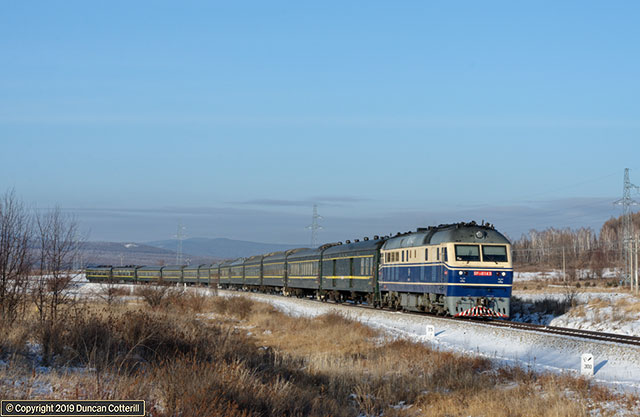
MAIN LINE MODERN TRACTION
Apart from the diesels on the Wujiu and Sandaoling mine railways, we also saw a reasonable number of diesels and electrics on the national system. Individual locos and workings identified are listed here.
We travelled on roads that parallel this section twice in daylight and saw several freights but no passenger trains. All the freights were worked by HXN5 diesels, in spite of the electrification having appeared to be almost complete 12 months ago. Perhaps they used the same contractors as the much delayed GWML electrification!
With more activity at Wujiu this year, there were fewer chances to observe operations on the main line but we did see five passenger trains and a couple of freights. The passengers were all worked by Sankeshu based DF11s and one of the freights was hauled by an HXN5. The loco on the other freight wasn’t seen. Train 4181/4184, which was worked by a DF4B last year, was seen once but was DF11 hauled this time.
Our route to Sandaoling took us fairly close to this line and one freight was seen closely enough to identify the loco as an HXD3 electric but not closely enough to identify the particular variety of HXD3, most likely a B but possibly a C.
Apart from the diesels on the Wujiu and Sandaoling mine railways, we also saw a reasonable number of diesels and electrics on the national system. Individual locos and workings identified are listed here.
Haila’er -Yakeshi
We travelled on roads that parallel this section twice in daylight and saw several freights but no passenger trains. All the freights were worked by HXN5 diesels, in spite of the electrification having appeared to be almost complete 12 months ago. Perhaps they used the same contractors as the much delayed GWML electrification!
Yakeshi - Yitulihe
With more activity at Wujiu this year, there were fewer chances to observe operations on the main line but we did see five passenger trains and a couple of freights. The passengers were all worked by Sankeshu based DF11s and one of the freights was hauled by an HXN5. The loco on the other freight wasn’t seen. Train 4181/4184, which was worked by a DF4B last year, was seen once but was DF11 hauled this time.
Hami - Tulufan (Turpan)
Our route to Sandaoling took us fairly close to this line and one freight was seen closely enough to identify the loco as an HXD3 electric but not closely enough to identify the particular variety of HXD3, most likely a B but possibly a C.
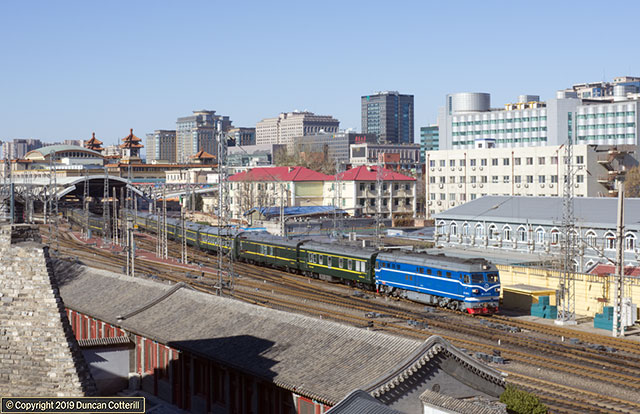
Something Old
The DF4C diesels are now around 20 years old, positively ancient by Chinese locomotive standards and no doubt soon for the chop as electrification proceeds apace. DF4C.0003, actually numbered DF4.0003 but not to be confused with the even older loco that carried that number, left Beijing with the empty stock of train T298 from Mudanjiang on the morning of 26 November 2017.Beijing Main Station
Nothing particularly exotic was seen on our first visit on 18 November, just the usual locos of classes SS9G, HXD3C and HXD3D plus a few SS8, SS9, DF4D, DF7C and DF11G. Trains from the south seemed to be severely delayed, which made identification of individual workings problematic.
On 26 November everything ran close to right time and the balance had changed with more SS9G and fewer of the HXD3 variants. This time there was also more of interest with an HXD1D on T110 from Shanghai, DF11Z.0001 on T5687 to Qinhuangdao and decorated DF11.0160 on 6452 from Yangcun.
Something New
HXD1D.0133 propelled the empty stock of train T110, the 18:02 Shanghai - Beijing overnight, back to the carriage sidings after its arrival in the capital on 26 November 2017. The HXD1D is Zhuzhou's answer to the Dalian built HXD3D. Both are 10,000HP, 160km/h passenger locomotives.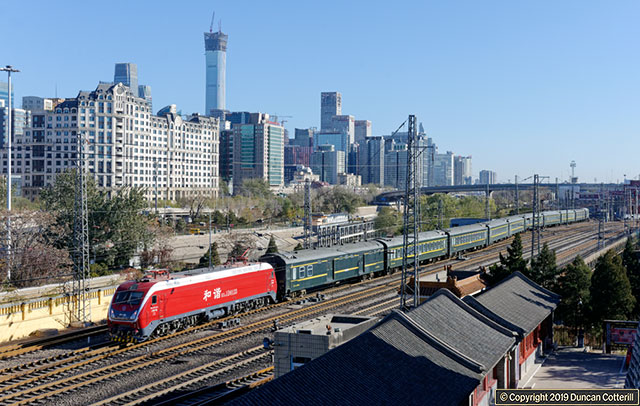
Beijing Northern Loop Line
This line loops around the north and east sides of Beijing, linking to the Beijing Bei - Nankou line near Shahe, in the north-west, and the direct line to Qinhuangdao and the southern loop line near Beijing Dong, in the south-east. In the days before Beijing Xi opened, it used to be the main route into Beijing for passenger trains from the Datong direction.
The loop line can be observed for several km from the parallel Line 13 of the Beijing Subway, which belies its name on this route by being mostly overground. The loop line used to be electrified but the wires have gone, leaving only the concrete masts standing. Its current lowly status is confirmed by the fact that it passes through a heavily populated urban area but is still unfenced.
The loop line was clearly still in use as the rails were reasonably shiny and we saw DF4D.4135 stabled in the sidings at Huangtudian on a set of empty stock. A DF7C was also there in the morning when we passed but had gone when we returned in the middle of the afternoon, replaced by DF4D.4120 on a rake of C70s or similar wagons.
At the junction with the Beijing Bei - Nankou line, south of Shahe, much construction work was in progress with all the rails removed and all lines apparently severed, although a connection between the Beijing Dong and Nankou directions was still be in place. There were certainly no lines going towards Beijing Bei at the time. A very impressive flying junction looked like it was being built there, probably in conjunction with the construction of a high speed line in the direction of Datong.
There’s a 2-platform terminus connected to the loop line just before Huangtudian and facing west. A modern streamlined DMU in CRH style livery was in the station when we passed in the morning but had gone by the afternoon. This was a mystery at the time but it appears that the terminus is a temporary station, used by tourist trains to the Great Wall at Badaling while the approaches to Beijing Bei are rebuilt. Huangtudian is adjacent to Huoying Subway station.
